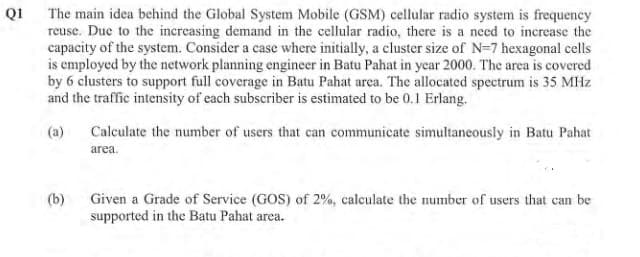The main idea behind the Global System Mobile (GSM) cellular radio system is frequency reuse. Due to the increasing demand in the cellular radio, there is a need to increase the capacity of the system. Consider a case where initially, a cluster size of N=7 hexagonal cells is employed by the network planning engineer in Batu Pahat in year 2000. The area is covered by 6 clusters to support full coverage in Batu Pahat area. The allocated spectrum is 35 MHz and the traffic intensity of each subscriber is estimated to be 0.1 Erlang. Calculate the number of users that can communicate simultaneously in Batu Pahat area. (b) Given a Grade of Service (GOS) of 2%, calculate the number of users that can be supported in the Batu Pahat area.
The main idea behind the Global System Mobile (GSM) cellular radio system is frequency reuse. Due to the increasing demand in the cellular radio, there is a need to increase the capacity of the system. Consider a case where initially, a cluster size of N=7 hexagonal cells is employed by the network planning engineer in Batu Pahat in year 2000. The area is covered by 6 clusters to support full coverage in Batu Pahat area. The allocated spectrum is 35 MHz and the traffic intensity of each subscriber is estimated to be 0.1 Erlang. Calculate the number of users that can communicate simultaneously in Batu Pahat area. (b) Given a Grade of Service (GOS) of 2%, calculate the number of users that can be supported in the Batu Pahat area.
Operations Research : Applications and Algorithms
4th Edition
ISBN:9780534380588
Author:Wayne L. Winston
Publisher:Wayne L. Winston
Chapter8: Network Models
Section8.6: Minimum Spanning Tree Problems
Problem 4P
Related questions
Question

Transcribed Image Text:Q1
The main idea behind the Global System Mobile (GSM) cellular radio system is frequency
reuse. Due to the increasing demand in the cellular radio, there is a need to increase the
capacity of the system. Consider a case where initially, a cluster size of N=7 hexagonal cells
is employed by the network planning engineer in Batu Pahat in year 2000. The area is covered
by 6 clusters to support full coverage in Batu Pahat area. The allocated spectrum is 35 MHz
and the traffic intensity of each subscriber is estimated to be 0.1 Erlang.
(a)
(b)
Calculate the number of users that can communicate simultaneously in Batu Pahat
area.
Given a Grade of Service (GOS) of 2%, calculate the number of users that can be
supported in the Batu Pahat area.
Expert Solution
This question has been solved!
Explore an expertly crafted, step-by-step solution for a thorough understanding of key concepts.
Step by step
Solved in 2 steps

Knowledge Booster
Learn more about
Need a deep-dive on the concept behind this application? Look no further. Learn more about this topic, computer-science and related others by exploring similar questions and additional content below.Recommended textbooks for you

Operations Research : Applications and Algorithms
Computer Science
ISBN:
9780534380588
Author:
Wayne L. Winston
Publisher:
Brooks Cole

Operations Research : Applications and Algorithms
Computer Science
ISBN:
9780534380588
Author:
Wayne L. Winston
Publisher:
Brooks Cole